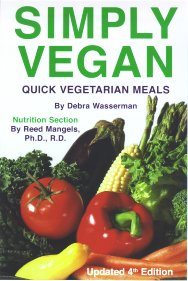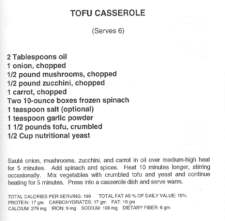
|
VRG Home | About VRG | Vegetarian Journal | Books | Vegetarian Nutrition F.A.Q. | Subscribe to Journal | Game | Vegetarian Family | Nutshell | VRG-News Recipes | Travel | What's New | Veg Kids | Search | Links |

Simply Vegan
Quick Vegetarian Meals, Vegan Nutrition, and Cruelty-Free Shopping
by Debra Wasserman and Reed Mangels, Ph.D., R.D.
ISBN 0-931411-30-0
224 pages, recycled paper
Fourth Edition
Click Here To Order
Or call (410) 366-8343 to order from us directly.
The immensely popular Simply Vegan is now available in a Fourth Edition. Simply Vegan is much more than a cookbook. It is a guide to a non-violent, environmentally sound, humane lifestyle. It features:
- Over 160 vegan recipes that can be prepared quickly.
- An extensive vegan nutrition section writtin by Reed Mangels, Ph.D., R.D., on topics such as Protein, Fat, Calcium, Iron, Vitamin B12, Pregnancy and the Vegan Diet, Feeding Vegan Kids, and Calories, Weight Gain, and Weight Loss. A Nutrition Glossary is provided.
- Sample Menus and Meal Plans for Vegans.
- Food Definitions and Origins including common and uncommon vegan foods, as well as Herbs and Spices.
- Cruelty-Free Shopping including where to buy vegan food, clothing, cosmetics, household products, and books.
- 85,000+ copies of Simply Vegan already sold.
Quote from a well-known vegetarian activist: "This book truly is the Bible of veganism. I have found it to be an indispensable reference source for combating the ignorance and misinformation that one often encounters as an activist for health, animals, and the environment."
From the Foreword by Debra Wasserman
Simply Vegan is more than a cookbook. It is a guide to a non-violent, environmentally sound, humane lifestyle.
Long ago, I became vegan for ethical reasons. As a graduate student studying International Relations at Georgetown University, I often found myself having to justify my strong beliefs in pacifism. In course after course on foreign policy making, I felt that I was the only one in my graduate class who saw war as the last option for settling disputes. With the exception of one other classmate from Venezuela, I was the only student who truly believed in promoting non-violence.
One evening as I sat around the dinner table with several non-vegetarian classmates, one person asked me if I ate meat. I replied, "yes." To which he added, "Isn't killing animals for food a violent act?" My response was that animals are not people. However, after that evening's discussion I immediately became vegetarian. I quickly realized that killing animals for food was not only unnecessary and inconsistent with my own non-violent lifestyle, but that raising animals for food was destroying our environment and in many cases ruining our health, too.
As time goes on, I find that eating a vegan diet, using ecologically sound products that have not been tested on animals, and wearing clothes made from non-animal sources is not difficult, as long as you know where to shop for these items. Six years ago I saw the need to create a convenient guide to vegan living. Simply Vegan is that resource. Now in its fourth edition, I hope this book makes your life simpler.
Debra Wasserman
Baltimore, Maryland
Please Note: The contents of Simply Vegan are not intended to provide medical advice. Medical advice should be obtained from a qualified health professional.
From the section on Iron Nutrition by Reed Mangels
Summary: Dried beans and dark green leafy vegetables are especially good sources of iron, even better on a per-calorie basis than meat. Iron absorption is increased markedly by eating foods containing vitamin C along with foods containing iron. Vegetarians do not have a higher incidence of iron deficiency than do meat eaters.
Iron is an essential nutrient because it is a central part of hemoglobin which carries oxygen in the blood. Iron deficiency anemia is a worldwide health problem which is especially common in young women and in children.
Iron is found in food in two forms, heme and non-heme iron. Heme iron, which makes up 40 percent of the iron in meat, poultry, and fish is well absorbed. Non-heme iron, 60 percent of the iron in animal tissue and all the iron in plants (fruits, vegetables, grains, nuts) is less well absorbed. Vegan diets only contain non-heme iron. Because of this, iron recommendations are higher for vegetarians (including vegans) than for non-vegetarians. The RDA for iron is 14 milligrams per day for vegetarian men and for women after menopause, and 33 milligrams per day for women prior to menopause (1)
Some might expect that since the vegan diet contains a form of iron which is not that well absorbed, vegans might be prone to developing iron deficiency anemia. However, recent surveys of vegans (2, 3) have shown that iron deficiency anemia is no more common among vegetarians than among the general population although vegans tend to have lower iron stores (3).
The reason for the satisfactory iron status of many vegans may be that commonly eaten foods are high in iron, as Table 11 shows. In fact, if the amount of iron in these foods is expressed as milligrams of iron per 100 calories, many foods eaten by vegans are superior to animal-derived foods. This concept is illustrated in Table 12. For example, you would have to eat more than 1700 calories of sirloin steak to get the same amount of iron as found in 100 calories of spinach.
Another reason for the satisfactory iron status of vegans is that vegan diets are high in vitamin C. Vitamin C acts to markedly increase absorption of non-heme iron. Adding a vitamin C source to a meal increases non-heme iron absorption up to six-fold which makes the absorption of non-heme iron as good or better than that of heme iron (4).
Fortunately, many vegetables, such as broccoli and bok choy, which are high in iron are also high in vitamin C so that the iron in these foods is very well absorbed. Commonly eaten combinations, such as beans and tomato sauce or stir-fried tofu and broccoli, also result in generous levels of iron absorption.
It is easy to obtain plenty of iron on a vegan diet. Table 13 shows several menus which would meet the RDA for iron.
Both calcium and tannins (found in tea and coffee) reduce iron absorption. Tea, coffee, and calcium supplements should be used several hours before a meal that is high in iron (5).
References
1. Institute of Medicine, food and Nutrition Board. Dietary Reference Intates for Vitamin A, Vitamin K, Arsenic, Boron, Chromium, Copper, Iodine, Iron, Manganese, Molybdenum, Nickel, Silicon, Vanadium, and Zinc. Washington, DC: National Acadamy Press, 2001.
2. Haddad EH, Berk LS, Kettering JD, Hubbard RW, Peters WR. Dietary intake and biochemical, hematologic, and immune status of vegans compared with nonvegetarians. Am J Clin Nutr 1999;70(suppl):586S-93S
3. Obeid R, Geisel J, Schoor H, et al. The imact of vegetarianism on some haematological parameters. Eur J Haematol. 2002:69:275-9.
4. Hallberg L. Bioavailability of dietary iron in man. Ann Rev Nutr 1981;1:123-147.
5. Gleerup A, Rossander Hulthen L, Gramatkovski E, et al. Iron absorption from the whole diet: comparison of the effect of two different distributions of daily calcium intake. Am J Clin Nutr 1995;61:97-104.
[There follows 4 pages of tables of data on iron nutrition for vegans.]
Sample Recipe by Debra Wasserman

Table of Contents
- Foreword
- Time-Saving Cooking Suggestions
- Microwave Cooking
- Introducing Fat as a Percentage of Daily Value
- Sample Menus
- Menu Analysis
- Top Recipes for Calcium and Vitamin C
- Top Recipes for Iron
- Recipes
- Beverages
- Breakfasts
- Sandwiches
- Snacks
- Salads
- Soups
- Side Dishes
- Main Dishes
- Pasta Dishes
- Soy Products
- Tempeh Dishes
- Tofu Dishes
- Desserts
- Food Definitions and Origins
- Herbs and Spices
- Vegan Nutrition
- Introduction
- Nutrition is a Science
- Recommendations for Vegans
- Calories, Weight Gain, and Weight Loss
- Protein
- Fat
- Calcium
- Iodine
- Iron
- Zinc
- Vitamin D
- Vitamin B12
- Sources of Vitamins and Minerals
- Pregnancy and the Vegan Diet
- Lactation and the Vegan Diet
- Feeding Vegan Kids
- Nutrition Glossary
- Recommended Reading List
- Cruelty-Free Shopping
- Vegan Food Through the Mail
- Vegan Food Products
- Vegan Soyfoods
- Cruelty-Free Cosmetics
- Environmentally Sound Household Products
- Clothing Containing No Animal Products
- Personal Care Products
- Educational Materials
- Recommended Reading List
- Index
- Index of Tables
- The Vegetarian Resource Group
Click Here To Order
 © 1996-2016 The Vegetarian Resource Group
© 1996-2016 The Vegetarian Resource Group PO Box 1463, Baltimore, MD 21203
(410) 366-8343 Email: vrg@vrg.org
The contents of this website and our other publications, including Vegetarian Journal, are not intended to provide personal medical advice. Medical advice should be obtained from a qualified health professional. We often depend on product and ingredient information from company statements. It is impossible to be 100% sure about a statement, info can change, people have different views, and mistakes can be made. Please use your own best judgment about whether a product is suitable for you. To be sure, do further research or confirmation on your own.
Web site questions or comments? Please email vrg@vrg.org.